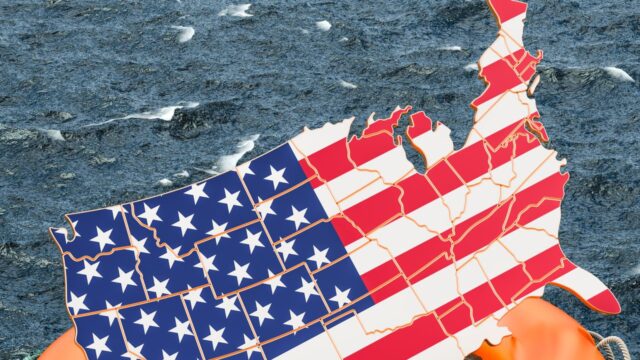The Crisis and Revolution Hidden in Plain Sight

According to both the mainstream media and social media, the forces that will shape the future are 1) AI (i.e. technology’s impact on jobs and growth), 2) geopolitical competition for AI dominance, energy, resources, trade, military and financial power, and 3) finance, which includes cryptocurrencies, stablecoins, Modern Monetary Theory (MMT), federal deficits, hyperinflation / currency devaluation and precious metals –all of which boil down to “what can I do to ensure that my wealth will remain intact whatever happens.”
The key issues are technology, finance and market forces–the core drivers of the global economy. Society isn’t on the menu other than as a quickly dismissed source of dutiful hand-wringing.
While all these will be influential, no one seems to see the domestic crisis hidden in plain sight or the revolution it makes inevitable. In my analysis, these will be the dominant forces shaping the coming decade.
As I have documented in recent posts–If We Measured the Economy by Quality-of-Life Instead of GDP, We’d Be In a Depression, For Many, This Recession Will Feel Like a Depression and Crunch Time for Cities, Counties and States—the system has reached its limits and is coming apart.
What is the crisis? There are three self-reinforcing dynamics in play.
The first is the imbalance of the economy and society: the economy now dominates society, and historically this leads to disorder. Everyone looking at technology and finance as the solutions has it backwards: technology and finance are the problems, not the solutions, as they are the primary drivers of the imbalance between society and the economy.
As I explain in my new book’s Introduction (free), society and the market forces that drive the economy have different timelines, tasks and priorities.
Market forces are focused on expanding new markets, heedless of consequences beyond profit and market share; the future consequences fall on society, which must take the long view and absorb the impacts on the workforce, social stability and the nation’s commons, i.e. the environment.
The second is that inequality–of wealth, income, opportunity and power–has reached extremes that can be visualized as a pendulum: pushed to an extreme, the pendulum will swing to the opposite extreme.
It’s not just inequality that’s reached an extreme–so has exploitation, artifice and moral decay.
The average income of the bottom 60% households is $38,000 annually, while to qualify as a top 10% household requires about $250,000 annually.
As I have documented here, insecurity can’t be measured solely by income–the other dynamic is precarity: the income of many households is variable, and unexpected expenses such as auto repairs or health emergencies (both of which have reached insane heights) can throw the household into a financial hole.
Those ignoring society to focus on the economy assume the bottom 60% of Americans–200 million people, 80 million households who own so little of the nation’s financial wealth that their share is a rounding error–will just uncomplainingly accept their accelerating impoverishment as prices for essential soar and wages don’t keep pace.
The problem with this assumption is this cohort is making too little money (even with increases in minimum wages) to afford the essentials of shelter, food, healthcare, childcare and transport.
Inflation is not dead; it’s already changed the landscape permanently. Lower-cost alternatives have dried up: even old cars and apartments in seedy neighborhoods cost a fortune now.
Those between the bottom 60% and the top 10%–the 30% who self-identify as “middle class”— may feel immune to precarity, but much of their financial stability rests on sands that will collapse in a recession / asset-bubble pop.
Their financial stability is fragile because it now rests on three fragile economic structures: 1) credit-asset bubbles that have increased “wealth” without increasing use-value; 2) the transfer of risk from corporations and the government to households, and 3) the “trickledown economy” where the wealthiest 10% now collect virtually all the non-wage income from income-producing assets and account for 50% of all spending–wealth and income that’s supposed to “trickle down” to the bottom 90%.
Once the asset bubbles pop and even the top 10% start experiencing job losses and declining income, the layoffs in the bottom 90% will cascade as spending dries up and stock portfolios and home values return to Earth.
Only those 62 and older were in the workforce in a “real recession,” i.e. one that can’t be reversed by the Federal Reserve lowering short-term interest rates and the federal government borrowing and spending more to “spend our way out of recession.” The last real recession was 43 years ago, 1981-82.
There is also a demographic dynamic in play globally: Gen Z is no longer accepting that massive inequality between generations is “the way it has to be.”
The second dynamic is the buffers that enabled people to hang on through recessions have all thinned: where debt was a modest percentage of GDP in the 1970s and 1980s recessions, now it’s at historic highs. Households have already tapped credit cards and so borrowing more money to get by is not an option.
So when push comes to shove–when hours are cut or a job is lost–the only choice is what not to pay: student loan, car payment, rent, as food and utilities take precedence.
The buffers are already thinned and we haven’t even slipped into recession yet.
The third dynamic is the least recognized: the moral decay that has pushed exploitation, profiteering and artifice to extremes, undermining the foundations of the economy and society.
Though it’s unseen, the economy and society both rest on moral foundations. As moral decay consumes those foundations, the consequences are social and economic decay.
The authentic market–defined by transparency and competition–has been replaced by monopolies and cartels that generate outsized profits not by increasing value but by reducing the value of products and services.
Profits flow not from improving durability and quality but by reducing them. There are words that describe our economy: exploitation, profiteering, predation, extraction.
Since political influence is now an open auction in which corporations place the winning bids, there is zero political interest or will to address the inequality divide. The current administration’s core economic policies are unchanged from 2008-09: cut taxes paid by the 10% (because they pay most of the income taxes), push interest rates down to goose borrowing, and inflate asset bubbles to create “the wealth effect.” That these only increase wealth and income inequality–who cares? Not the political class of either party.
We’ve succumbed to normalization: all this is “the way it is.”
But this is artifice: normalizing extremes doesn’t make them stable. The system has reached its limits and the social order is crumbling.
My new book Investing In Revolution describes the inevitable result: a social revolution, not a political one that replaces one ruling elite with another. This will be a revolution that changes values and restores social norms. We will all have the opportunity to invest in revolution.
To me, this is all in plain sight, but since nobody else sees it, it’s hidden in plain sight. The Introduction (free) is lengthy but it summarizes all the dynamics in play.
I tend to think this might be my most important book, as I sincerely doubt the next decade will be a simple extension of the last decade. Just as the Ming Empire crumbled when it reached its limits, our system has reached its limits; while we focus on AI and finance, society is crumbling beneath our feet.
https://charleshughsmith.substack.com/p/the-crisis-and-revolution-hidden
